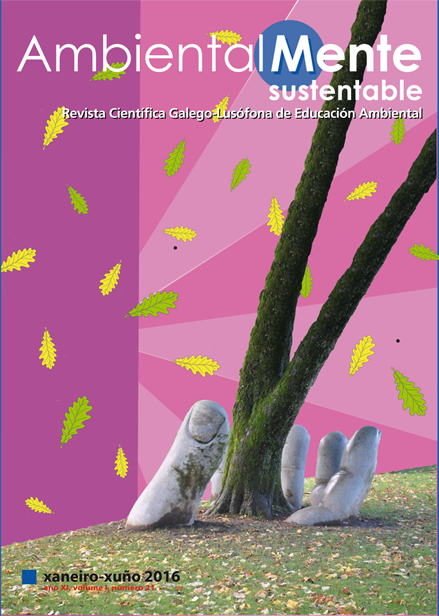Diagnóstico e estudo da dinámica socioambiental do parque ambiental Bernardo Berneck en Várzea Grande, Rexión metropolitana val do río Cuiaba
DOI:
https://doi.org/10.17979/ams.2016.01.021.1840Palabras clave:
áreas verdes, plano de manexo, Parque Ambiental Bernardo Berneck, organização do espaçoResumo
No espazo-tempo no que as selvas de pedra son un reflexo das idealizacións da mente humana e que a tecnoloxía é unha extensión das súas relacións, a natureza convértese nunha fuxida, non só física, senón psicolóxica de todo o contexto tóxico das cidades. O ser humano transforma o ambiente segundo as súas necesidades e a mesma distancia do natural que contribuíu á evolución motivou a existencia de parques urbanos, tanto para a construción de coñecemento ambiental como para o lecer. Polo tanto, o presente artigo, froito de investigacións teórico-metodolóxicas e de campo, intenta reflectir o papel do parque ambiental Bernardo Berneck no concello de Várzea Grande, situado na rexión metropolitana de Vale do Rio Cuiabá, en Mato Grosso, Brasil, como área de estudo ambiental e como axente organizador do espazo que presenta potenciais e debilidades que se deben empregar para que o poder público promova a sustentabilidade desta área.
##plugins.themes.default.displayStats.downloads##
Citas
Bauman, Zygmunt (2007). Tempos líquidos. Rio de Janeiro: Jorge Zahar.
Byron, Geroge Gordon. Childe Harold, Canto iv, Verso 178. 1812.
Ibge. Instituto Brasileiro de Geografia e Estatística. Disponível em: http://www.ibge.gov.br
Lefebvre, Henry 82001). O Direito à Cidade. Tradução de Rubens Eduardo Frias. São Paulo: Editor Centauro.
Lord Byron (1788-1824), poeta britânico. Mar de Outubro. Disponível em: http://mardeoutubro.blogspot.com.es/2008/06/h-nas-matas-cerradas-um-prazer-h-nas.html
Loboda, C. R.; De Angelis, B. L. D. (2005). Áreas verdes públicas urbanas: Conceitos, usos e funções. Ambiência-Revista do Centro de Ciências Agrárias e Ambientais, v. 1, n. 1, jan/jun. Disponível em: https://revistas.unicentro.br/index.php/ambiencia/article/view/158
Medeiros, João de Deus (2011).Guia de campo: vegetação do Cerrado 500 espécies. Brasília: MMA/SBF. (Série Biodiversidade, 43).
Scalise, W. Parques Urbanos – Evolução, Projeto, Funções e Usos. Revista Assentamentos Humanos, Marília, v. 4, n. 1, pp. 17-24, 2002. Disponível em: http://www.unimar.br/feat/assent_humano4/parques.htm.
Sochava, V.B. Introdução à Teoria do Geossistema. Novasibéria: Nauka. 1978. 320 pp. em russo.
Troppmair, Hulmut. Biogeografia e Meio Ambiente/Helmut Troppmair - 8ª edição - Rio Claro: Divisa, 2008. 227 pp.
Descargas
Publicada
Número
Sección
Licenza
Os traballos publicados nesta revista están baixo unha licenza Creative Commons Recoñecemento-CompartirIgual 4.0 Internacional.
Permitese e anímase aos autores a difundir os artigos aceptados para a súa publicación nos sitios web persoais ou institucionais, antes e despois da súa publicación, sempre que se indique claramente que o traballo pertence a esta revista e se proporcionen os datos bibliográficos completos xunto co acceso ao documento.



